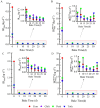In vitro simulation of the bioavailability of fluoride in food roasted with high-fluoride fuel and its health risks
- PMID: 40271432
- PMCID: PMC12014449
- DOI: 10.3389/fnut.2025.1560015
In vitro simulation of the bioavailability of fluoride in food roasted with high-fluoride fuel and its health risks
Abstract
Fluorosis in coal-burning areas of Southwest China is exacerbated by multi-pathway fluoride exposure, with diet emerging as a critical factor due to traditional food preparation methods. This study systematically evaluated fluoride accumulation, bioavailability, and health risks associated with foods roasted over high-fluoride coal, with a particular focus on chili-a dietary staple with heightened fluoride absorption and bioavailability. Results indicated that after 30 days of roasting, chili's fluoride content reached 869.82 mg·kg-1, with bioavailability levels between 2.18 and 12.00%, making it the largest contributor to the hazard index (HI), accounting for over 80% of the total when bioavailability was considered. In comparison, corn, tofu, and pork, though accumulating fluoride to varying extents, presented lower bioavailability, and thus relatively lower health risks. Recent dietary shifts in the region show reduced corn consumption and increased chili and pork intake, further shifting dietary fluoride exposure risk toward high-bioavailability foods like chili. These findings highlight the need for dietary management interventions in high-fluoride regions, prioritizing moderated chili consumption and revised cooking practices to mitigate fluorosis risk effectively.
Keywords: bioavailability; coal roasting; fluoride; food; health risk assessment.
Copyright © 2025 Zhang, Luo, Tu, Yang, Tang and Tu.
Conflict of interest statement
The authors declare that the research was conducted in the absence of any commercial or financial relationships that could be construed as a potential conflict of interest.
Figures






Similar articles
-
The daily fluorine and arsenic intake for residents with different dietaries and fluorosis risk in coal-burning fluorosis area, Yunnan, Southwest China.Environ Sci Pollut Res Int. 2015 Feb;22(3):2031-40. doi: 10.1007/s11356-014-3485-4. Epub 2014 Aug 29. Environ Sci Pollut Res Int. 2015. PMID: 25167821
-
Coal-burning roasted corn and chili as the cause of dental fluorosis for children in southwestern China.J Hazard Mater. 2011 Jan 30;185(2-3):1340-7. doi: 10.1016/j.jhazmat.2010.10.052. Epub 2010 Oct 20. J Hazard Mater. 2011. PMID: 21074315
-
Analysis of multiple pathways and levels of fluoride intake in fluorosis areas of Southwest China.Heliyon. 2023 Feb 11;9(3):e13651. doi: 10.1016/j.heliyon.2023.e13651. eCollection 2023 Mar. Heliyon. 2023. PMID: 36851961 Free PMC article.
-
Dietary glycation compounds - implications for human health.Crit Rev Toxicol. 2024 Sep;54(8):485-617. doi: 10.1080/10408444.2024.2362985. Epub 2024 Aug 16. Crit Rev Toxicol. 2024. PMID: 39150724
-
Fluoride in the environment and its metabolism in humans.Rev Environ Contam Toxicol. 2011;211:121-42. doi: 10.1007/978-1-4419-8011-3_4. Rev Environ Contam Toxicol. 2011. PMID: 21287392 Review.
References
-
- Sun D, An D. Coal-Burning Type of Endemic Fluorosis Control and Practice in China. BeiJing: The People's Health Press; (2017).
LinkOut - more resources
Full Text Sources

